UPS不间断电源安装培训手册
- 格式:docx
- 大小:208.91 KB
- 文档页数:12
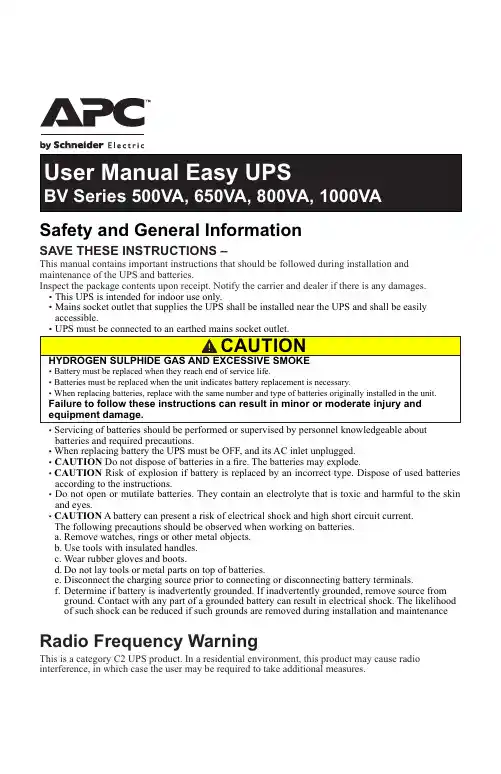
00 1000Safety and General InformationSAVE THESE INSTRUCTIONS –This manual contains important instructions that should be followed during installation and maintenance of the UPS and batteries.Inspect the package contents upon receipt. Notify the carrier and dealer if there is any damages.• This UPS is intended for indoor use only.• Mains socket outlet that supplies the UPS shall be installed near the UPS and shall be easilyaccessible.•batteries and required precautions.•When replacing battery the UPS must be OFF, and its AC inlet unplugged.• CAUTION Do not dispose of batteries in a re. The batteries may explode.•CAUTION Risk of explosion if battery is replaced by an incorrect type. Dispose of used batteries according to the instructions.•Do not open or mutilate batteries. They contain an electrolyte that is toxic and harmful to the skin and eyes.•CAUTION A battery can present a risk of electrical shock and high short circuit current.The following precautions should be observed when working on batteries.a. Remove watches, rings or other metal objects.e tools with insulated handles.c. Wear rubber gloves and boots.d.Do not lay tools or metal parts on top of batteries.e. Disconnect the charging source prior to connecting or disconnecting battery terminals.f.Determine if battery is inadvertently grounded. If inadvertently grounded, remove source fromground. Contact with any part of a grounded battery can result in electrical shock. The likelihood of such shock can be reduced if such grounds are removed during installation and maintenanceRadio Frequency WarningThis is a category C2 UPS product. In a residential environment, this product may cause radio interference, in which case the user may be required to take additional measures.FeaturesON/OFF button with indicator Battery connector Input power cordCircuit breakerEasy UPS BV Series 500VA, 650VA, 800VA, 1000VA2Place and Power On1. Place the Easy UPS to avoid :• Direct sunlight • Excessive heat • Excessive moisture • Excessive dust/dirtFor operation, please place the unit on the floor.2. Connect the battery by pulling the battery handle up,and then pushing it into the unit.4. Plug the Easy UPS power cord directly into a wall outlet, not into a surge protector or power strip.5. Press the ON/OFF button to turn on the unit.The green “Power On” indicator confirms that the Easy UPS is on and ready to provide protection.The Easy UPS should charge for at least 6 hours to ensure sufficient runtime. The unit is being charged whenever it is connected to AC power, whether the unit is turned ON or OFF.*only for model with Schuko outletBattery backup and surge protected outletsAC power inlet with AC fuse*only for model with Schuko outlet36-8 Hours 9.25 cm x 16.05 cm x 30.5 cmSpecificationsInputOutputProtection BatteryPhysicalV oltage Frequency230 V AC 50 Hz or 60 Hz Brownout Transfer Over-voltage Transfer170 V AC, typical 280 V AC, typicalUPS Capacity (total)500V A / 300W V oltage On Battery 230V AC 10%± Frequency - On Battery Transfer Time50 Hz / 60 Hz ± 1Hz6ms typicalTypical Recharge TimeNet WeightDimensions (Hx Wx D)12V , 7AH lead acid650V A / 375W 800V A / 450W 1000V A / 600W12V , 4.5AH lead acid4.5 kg3.9 kg5.3 kg5.7 kg12V , 7AH lead acid12V , 9AH lead acidThe battery typically lasts for three to ve years.Environmental factors impact battery life.Elevated temperatures, high humidity, poor quality mains power, and frequent, short duration discharges will shorten battery life.The battery in the Easy UPS Series is not user-replaceable.Contact SEIT Technical Support for a list of authorized service centers near you.ModelWall Mount Installation• Horizontal installation, use 2 screws 11.1"(282 mm) apart.• Allow 5/16'’ (8 mm), of the screw to protrude from the wall.Easy UPS BV Series 500VA, 650VA, 800VA, 1000VA AC InputCircuit Breaker*(*only for model with Schuko outlet)Type(maintenance-free)Average Life5A 5A 7A 7A AC Input Fuse5A 5A 10A 10A BV500IBV650IBV800IBV1000ILED ConditionOnOff Constant ToneOn (Off during 4 beeps) 4 beeps repeatedevery 30 secondsFlashingConstant beeping (every 1/2 second) Constant toneOffShort beep every 4 seconds Constant ToneAudible AlarmLong beep every 4 secondsS tatus IndicatorsOn-line - The Easy UPS is supplying AC power to the connected equipmentOn Line Overload - The power being used by the connected equipment has exceeded the capacity of the unit.Disconnect some equipment.Over-temperature - The unit is overheating and will operate in A VR mode for 5 minutes. The Easy UPS will shut down if the temperature is not lowered. Disconnect some of the connected equipment.On-Battery - The Easy UPS is supplying battery power.Low Battery - The Easy UPS is supplying battery power and the battery is near a total discharge state.Bad Battery Detected - The battery needs to be charged,or is at end of life.Low Battery Shutdown - During On Battery operation the battery power was almost completely exhausted, and the Easy UPS is waiting for AC power to return to normal.On Battery Overload - The connected equipment requires more power than provided by the Easy UPS battery.Unplug devices one at a time to remove overload. If the problem is not corrected, contact SEIT Technical SupportCharger Detected Fault - Easy UPS has an internal problem,and is no longer powering the load.Contact SEIT Technical SupportOver-temperature Protected - The Easy UPS hasoverheated and has shut down. Unplug connected devices one at a time or wait for a few hours for system to cool down.Constant b eeping (every 1/2 s econd)4Easy UPS BV Series 500VA, 650VA, 800VA, 1000VAOperational FeaturesAutomatic V oltage Regulation boosts/trims the AC voltage when it drops/exceeds levels.This allows the equipment plugged into the unit to operate during low/high voltage conditions, conserving the battery power in the event of a power cut.The Easy UPS will switch to battery power if the input voltage level becomes too low/high for the Automatic V oltage Regulation to compensate, or if the AC power is distorted.Automatic Voltage Regulation (AVR)TroubleshootingProblem and Possible CauseThe Easy UPS will not turn onThe Easy UPS has not been turned on.SolutionPress the ON/OFF button.Make sure the power cord is securely connected to the wall outlet, and that there is AC power available at the wall outlet.Where applicable, check that the wall outlet is switched on.Remove all nonessential equipment connected to theoutlets. One at a time reconnect equipment to the Easy UPS.Charge the battery for 24 hours to make sure it is fully charged. If the overload condition still occurs, replace the battery.The Easy UPS is not connected to AC power,there is no AC power available at the wall outlet, or the AC power is experiencing a brownout or over voltage condition.The battery is disconnected.Connected equipment loses powerA Easy UPS overload condition has occurred.The Easy UPS battery is completely discharged.The Easy UPS may require service.The Easy UPS is operating on battery power.The Easy UPS battery has approximately empty and will shutdownThe ON/OFF button is green and ashing every 30 seconds. 4 beeps repeated every 30 seconds.The ON/OFF button ashes green and constant beeps every 1/2 second.Connected equipment does not accept the step-approximated sine waveform from the Easy UPS.Refer to the Place and Power On on page 2.Connect the Easy UPS to AC power and allow the battery to recharge for ten hours.Contact Schneider Electric Technical Support for more in depth troubleshootingThe Easy UPS is operating normally on batterypower. At this point the user should save all open les,and shutdown the computer. When AC power is restored the battery will recharge.The Easy UPS battery is near a total discharge state.At this point the user should save all open les, and shutdown the computer. When AC power is restored the battery will recharge.The output waveform is intended for computers and peripheral devices. It is not intended for use with motor driven equipment.The Easy UPS has an inadequate battery runtime The battery is not fully charged.The battery is near the end of useful life and should be replaced.Leave the Easy UPS connected to AC power for ten hours while the battery charges to full capacity.As a battery ages, the runtime capability decreases.The UPS have shut down due to low battery,but control power exists.The UPS and outlets are off but the UPS keeps beeping once every 4 seconds. The alarm will mute after 32 seconds.The UPS will return to normal operation once the AC input voltage has returned to a normal range.5Easy UPS BV Series 500VA, 650VA, 800VA, 1000VAServiceIf the unit requires service, do not return it to the dealer. Follow these steps:1. Review the Troubleshooting section of the manual to eliminate common problems.2. If the problem persists, contact Schneider Electric IT (SEIT) Customer Support through the APC by Schneider Electric website, .a. Note the model number and serial number and the date of purchase. The model and serial numbers are located on the rear panel of the unit.b.Call SEIT Customer Support and a technician will attempt to solve the problem over the phone. If this is not possible, the technician will issue a Returned Material Authorization Number (RMA#).c. If the unit is under warranty, the repairs are free.d.Service procedures and returns may vary internationally. Refer to the APC by Schneider Electric website for country specific instructions.3. Pack the unit in the original packaging whenever possible to avoid damage in transit. Never use foam beads for packaging. Damage sustained in transit is not covered under warranty.4. Always DISCONNECT THE UPS BATTERIES before shipping. The United States Department of Transportation (DOT), and the International Air Transport Association (IATA) regulations require that UPS batteries be disconnected before shipping. The internal batteries may remain in the UPS.5. Write the RMA# provided by Customer Support on the outside of the package.6. Return the unit by insured, pre-paid carrier to the address provided by Customer SupportAPC by Schneider Electric IT Customer Support WorldwideWarrantyRegister y our p roduct o n-line. h ttp://The standard warranty is two (2) years from the date of purchase. SEIT standard procedure is to replace the original unit with a factory reconditioned unit. Customers who must have the original unit back due to the assignment of asset tags and set depreciation schedules must declare such a need at first contact with an SEIT Technical Support representative. SEIT will ship the replacement unit once the defective unit has been received by the repair department, or cross-ship upon the receipt of a valid credit card number. The customer pays for shipping the unit to SEIT. SEIT pays ground freight transportation costs to ship the replacement unit to the customer.For country specific customer support, go to the APC by Schneider Electric website, www .apc .com .EN 990-91065A01/2019© 2019 APC by Schneider Electric. APC, the APC logo are owned by Schneider Electric Industries S.A.S., or their af liated companies. All other trademarks are property of their respective owners.。
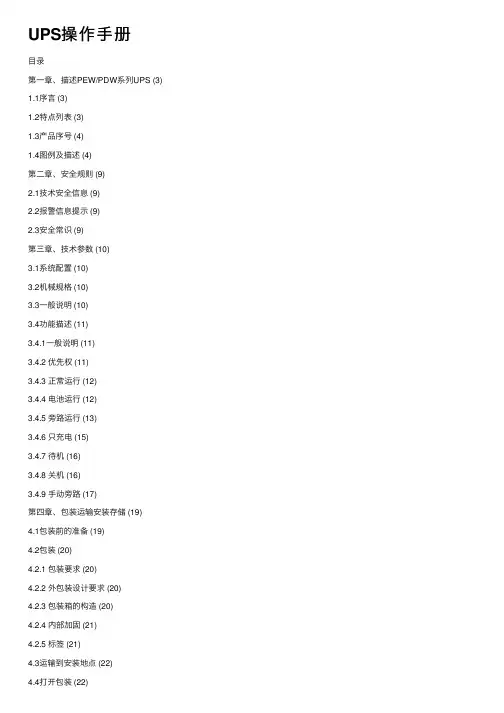
UPS操作⼿册⽬录第⼀章、描述PEW/PDW系列UPS (3) 1.1序⾔ (3)1.2特点列表 (3)1.3产品序号 (4)1.4图例及描述 (4)第⼆章、安全规则 (9)2.1技术安全信息 (9)2.2报警信息提⽰ (9)2.3安全常识 (9)第三章、技术参数 (10)3.1系统配置 (10)3.2机械规格 (10)3.3⼀般说明 (10)3.4功能描述 (11)3.4.1⼀般说明 (11)3.4.2 优先权 (11)3.4.3 正常运⾏ (12)3.4.4 电池运⾏ (12)3.4.5 旁路运⾏ (13)3.4.6 只充电 (15)3.4.7 待机 (16)3.4.8 关机 (16)3.4.9 ⼿动旁路 (17)第四章、包装运输安装存储 (19)4.1包装前的准备 (19)4.2包装 (20)4.2.1 包装要求 (20)4.2.2 外包装设计要求 (20)4.2.3 包装箱的构造 (20)4.2.4 内部加固 (21)4.2.5 标签 (21)4.3运输到安装地点 (22)4.4打开包装 (22)4.5存储 (22)4.5.1 UPS系统(设备) (22)4.5.2 电池 (22)4.6安装 (22)4.6.1通风 (22)4.6.2 安装、配线、保险 (23)4.6.3 负载 (23)第五章、显⽰— 操作和显⽰⾯板 (24)5.1显⽰⾯板 (24)5.1.1改变操作参数 (25)5.1.2通过显⽰器进⾏测量 (27)5.1.3 显⽰器上的报警信息 (28)5.1.4 告警信息记录 (30)5.2操作⾯板 (31)5.3操作状态指⽰灯 (31)5.4报警指⽰灯说明 (32)第六章、启动/运⾏ (33)6.1启动UPS (33)6.2由正常运⾏切换⾄旁路 (33)6.3从旁路运⾏切换⾄正常运⾏ (33)6.4切换⾄⼿动旁路 (34)6.5由⼿动旁路切换⾄正常运⾏ (34)6.6UPS的停机 (35)6.7UPS试运⾏ (35)第七章、维护 (37)7.1⽉检 (37)7.2半年检查 (37)7.3电池的维护 (38)7.4维护维修合同,培训教程 (38)第⼋章、排除故障 (39)8.1排除简单故障 (39)8.2根据报警指⽰排除故障 (39)第⼀章、描述PEW/PDW系列UPS1.1 序⾔这本操作⼿册提供了UPS系统的建⽴、安装、调试、操作及维修的内容。
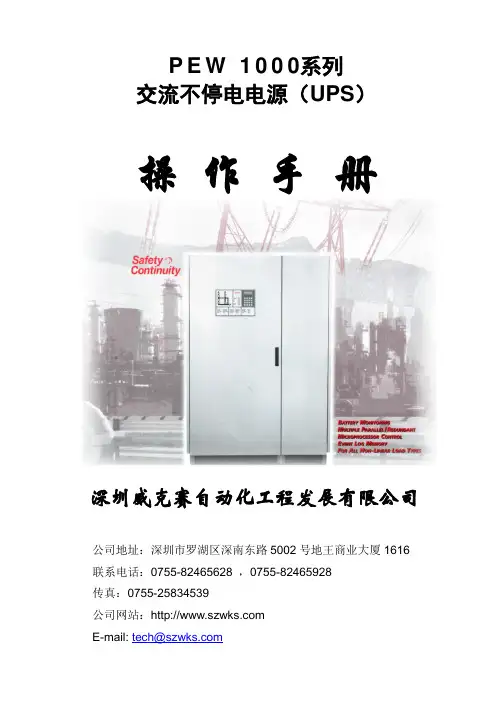
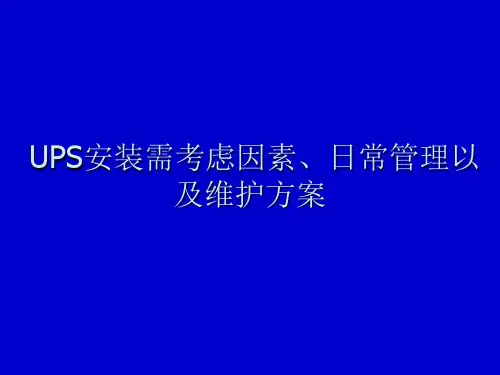
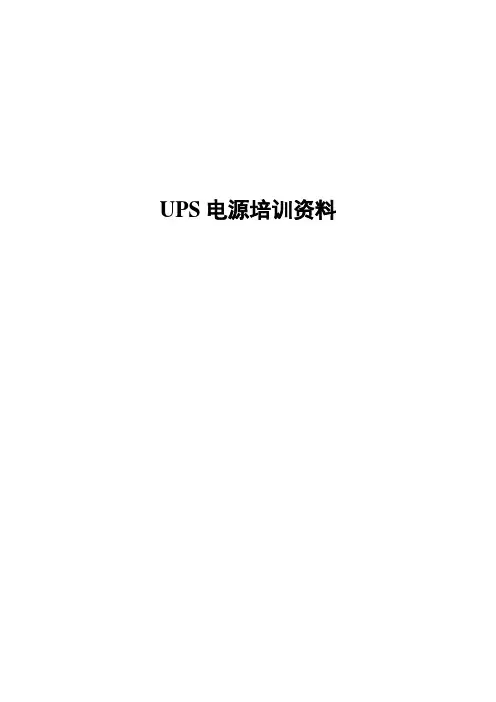
UPS电源培训资料CPU控制的PPS-500在线互动式UPS电源介绍简介PC PARTNER SERIES系列PPS-500UPS是美国OTC公司为适应个人电脑用户市场需求推出的一款最新一代CPU控制的智能型在线互动式正弦波不间断电源。
该产品集交流稳压电源、高速后备电源、浪涌吸收、隔离保护、通讯、网络管理等多种功能于一体,具有体积小、功能全、效率高、性能可靠等特点,可为客户的计算机提供优良的交流供电品质和可靠的后备保护,现场使用证明是真正可以依赖的PC伴侣。
1)工作介绍:标称值为220V/50HZ的市电电源经输入电源插座及其上的保险管(250V/6.3A)后进入UPS,先经过低通滤波器处理后,被同时送到:●微处理器的市电输入电压检测电路的输入端;●通过隔离变压器到电池充电器的输入端,对电池充电;●位于交流市电调压稳压装置的电路中RY1的常开触点上,经过稳压处理后再输出到负载。
这部分电路根据CPU检测之市电状态信息,经CPU判断处理后去控制相应的RY2、RY3、RY4继电器线圈,从而改变变压器绕组抽头的连接,最终达到稳压的目的,输出给负载。
其中RY1在市电允许范围内(±25%)时吸全,经稳压后输出给负载。
一旦市电超出此范围或市电中断,则RY1不吸全,负载由电池放电给逆变器工作供电,直到电池放电到终止电压UPS自动保护关机(电池终止电压10.2V左右)。
其主要回路原理是围绕一个多绕组的铁芯变压器来实现不间断稳压输出:输入绕组与输出绕组共用,并采用自耦全方式将绕组分成三个抽头,采用三个继电器实现分组调压稳压稳定市电输出;单独的充电绕组完成市电降压至可以对12V电池进行良好充电;逆变器绕组则采用半桥推挽逆变方式,在市电不符合要求时,电池通过逆变器PWM脉冲宽度调制方式逆变产生准正弦波由变压器升压后供给负载。
检测电路采用CPU测量计算判断,实现高速转换,保障电路实现负载不间断供电运行。
2)CPU控制I/O接口说明:输入端检测信号:●市电输入检测●电池电压检测●充电器电压检测●负载过流检测输出控制信号:●逆变器驱动信号●告警及指示灯信号●稳压输出控制信号各工作点电压:B+――电池端电压,市电正常时浮充电压应为13.8VVB――经LM78005稳压,输出应为5V电压,供CPU及比较器基准电源电压、蜂鸣器电源VC――为12V电压,供指示灯显示电源、比较器集成IC工作电源、逆变器驱动信号工作电源及RY1、RY2、RY3、RY4线圈驱动电源。
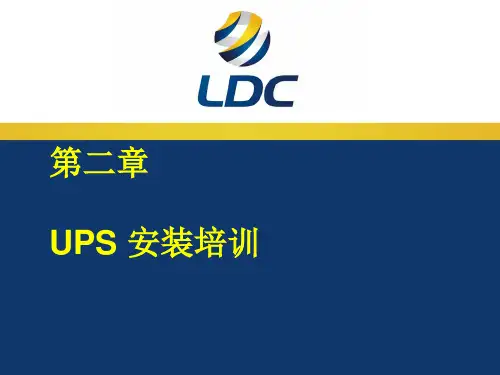
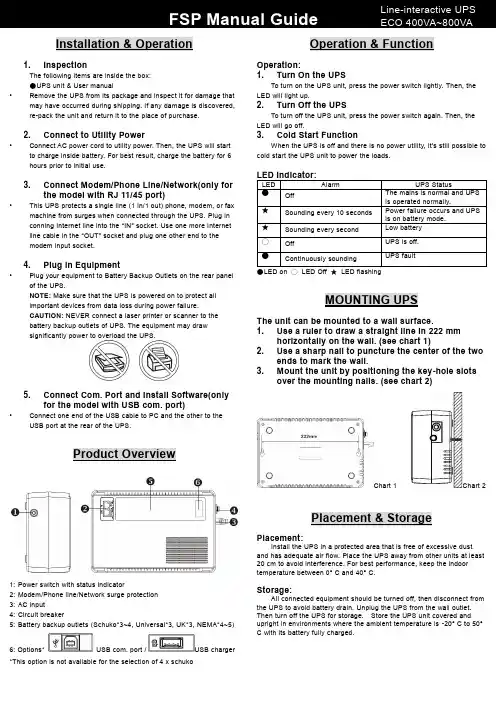
Installation & Operation1. InspectionThe following items are inside the box:●UPS unit & User manual•Remove the UPS from its package and inspect it for damage thatmay have occurred during shipping. If any damage is discovered,re-pack the unit and return it to the place of purchase.2. Connect to Utility Power•Connect AC power cord to utility power. Then, the UPS will startto charge inside battery. For best result, charge the battery for 6hours prior to initial use.3. Connect Modem/Phone Line/Network(only forthe model with RJ 11/45 port)•This UPS protects a single line (1 in/1 out) phone, modem, or faxmachine from surges when connected through the UPS. Plug inconning Internet line into the “IN” socket. Use one more Internetline cable in the “OUT” socket and plug one other end to themodem input socket.4. Plug in Equipment•Plug your equipment to Battery Backup Outlets on the rear panelof the UPS.NOTE: Make sure that the UPS is powered on to protect allimportant devices from data loss during power failure.CAUTION: NEVER connect a laser printer or scanner to thebattery backup outlets of UPS. The equipment may drawsignificantly power to overload the UPS.5. Connect Com. Port and Install Software(onlyfor the model with USB com. port)•Connect one end of the USB cable to PC and the other to theUSB port at the rear of the UPS.Product Overview1:Power switch with status indicator2:Modem/Phone line/Network surge protection3:AC input4:Circuit breaker5:Battery backup outlets (Schuko*3~4, Universal*3, UK*3, NEMA*4~5)6: Options* USB com. port /USB charger*This option is not available for the selection of 4 x schukoOperation & FunctionOperation:1. Turn On the UPSTo turn on the UPS unit, press the power switch lightly. Then, theLED will light up.2. Turn Off the UPSTo turn off the UPS unit, press the power switch again. Then, theLED will go off.3. Cold Start FunctionWhen the UPS is off and there is no power utility, it's still possible tocold start the UPS unit to power the loads.LED Indicator:LED Alarm UPS Status●Off The mains is normal and UPSis operated normally.★Sounding every 10 seconds Power failure occurs and UPSis on battery mode.★Sounding every second Low battery○Off UPS is off.●Continuously sounding UPS fault●LED on ○LED Off ★LED flashingMOUNTING UPSThe unit can be mounted to a wall surface.1. Use a ruler to draw a straight line in 222 mmhorizontally on the wall. (see chart 1)2. Use a sharp nail to puncture the center of the twoends to mark the wall.3. Mount the unit by positioning the key-hole slotsover the mounting nails. (see chart 2)Chart 1 Chart 2Placement & StoragePlacement:Install the UPS in a protected area that is free of excessive dustand has adequate air flow. Place the UPS away from other units at least20 cm to avoid interference. For best performance, keep the indoortemperature between 0° C and 40° C.Storage:All connected equipment should be turned off, then disconnect fromthe UPS to avoid battery drain. Unplug the UPS from the wall outlet.Then turn off the UPS for storage. Store the UPS unit covered andupright in environments where the ambient temperature is -20° C to 50°C with its battery fully charged.Safety cautionThis manual contains important instructions that should be followed during installation andmaintenance of the UPS and batteries.•This UPS utilizes voltage that may be hazardous. Do not attempt to disassemble the unit. The unit contains no user replaceableparts. Only factory service personnel may perform repairs.•This pluggable type A equipment with battery already installed by the supplier is operator installable and may be operated bylaymen.•The mains socket outlet that supplies the UPS shall be installed near the UPS and shall be easily accessible.•During the installation of this equipment it should be assured that the sum of the leakage currents of the UPS and the connectedloads does not exceed 3.5mA.•Connection to any other type of receptacle other than a two-pole, three-wire grounded receptacle may result in shock hazard aswell as violate local electrical codes.•In the event of an emergency, press the "OFF" button and disconnect the power cord from the AC power supply to properlydisable the UPS.•Do not allow any liquids or any foreign object to enter the UPS.•Do not place beverages or any other liquid-containing vessels on or near the unit.•This unit intended for installation in a controlled environment (temperature controlled, indoor area free of conductivecontaminants). Avoid installing the UPS in locations where thereis standing or running water, or excessive humidity.•Do not plug the UPS input into its own output.•Do not attach a power strip or surge suppressor to the UPS.•Do not attach non-computer-related items, such as medical equipment, life-support equipment, microwave ovens, or vacuumcleaners to UPS.•Do not dispose of batteries in a fire as they may explode.• A battery can present a risk of electrical shock and high short circuit current. The following precautions should be observedwhen working on batteries:1) Remove watches, rings, or other metal objects from the hands.2) Use tools with insulated handles.3) Wear rubber gloves and boots.4) Do not lay tools or metal parts on top of batteries.5) Disconnect charging source prior to connecting ordisconnecting batteries terminal.6)Remove battery grounds during installation and maintenance toreduce likelihood of shock.•Internal battery voltage is 12VDC.Sealed, lead-acid, 6-cell battery.•Servicing of batteries should be performed or supervised by personnel knowledgeable of batteries and the requiredprecautions. Keep unauthorized personnel away from batteries.•When replacing batteries, replace with the same number and type of sealed lead-acid battery.•Do not open or mutilate the battery or batteries. Release electrolyte is harmful to the skin and eyes. It may be toxic.•Attention, hazardous through electric shock. Also with dis- connection of this unit from the mains, hazardous voltage still may be accessible through supply from battery. The battery supplyshould be therefore disconnected in the plus and minus pole atthe connectors of the battery when maintenance or service workinside the UPS is necessary.•To reduce the risk of overheating the UPS, do not cover the UPS' cooling vents and avoid exposing the unit to direct sunlight orinstalling the unit near heat emitting appliances such as spaceheater or furnaces.•Unplug the UPS prior to cleaning and do not use liquid or spray detergent.TroubleshootingProblem Possible Cause SolutionsLED not lit.The UPS is noton.Press the power switch again toturn on the UPS.Battery voltageis too low.Charge the battery at least 6hours.Battery fault.Replace the battery.The UPSalways onbattery mode.Power cordloose.Re-plug the power cord.The UPScontinuouslybeeps.Please checkthe fault codefor the details.Please check the fault code forthe details.Backup timetoo short.Battery voltageis too low.Charge the battery at least 6hours.Overload.Remove some unnecessaryloads. Before reconnectingequipment, please verify that theload matches the UPS capabilityspecified in the specs.Battery defect.Replace the battery.If any abnormal situations occur that are not listed above, please call for service immediately.Specification400VA/600VA/800VAModel400600800 Capacity400VA/240W600VA/360W800VA/480WInput voltage220/230/240 VacInput VoltageRange162-290 VacOutput VoltageRegulation±10%(bat mode)Transfer Time Typical 2-6 msWaveform Simulated SinewaveBattery Type12V/4.5Ah12V/5Ah12V/5Ah Battery Number111 Charging Time 4 hours recover to 90% capacity Dimension(mm)245 x 163 x 90Net Weight (kgs) 3.5 4.0 4.5 Humidity0-90% RH @ 0-40°C non-condensing) Noise Level Less than 40dB*Specifications are subject to change without notice.Placement & StoragePlacement:Install the UPS in a protected area that is free of excessive dust and has adequate air flow. Place the UPS away from other units at least 20 cm to avoid interference. For best performance, keep the indoor temperature between 0° C and 40° C.Storage:All connected equipment should be turned off, then disconnect from the UPS to avoid battery drain. Unplug the UPS from the wall outlet. Then turn off the UPS for storage. Store the UPS unit covered and upright in environments where the ambient temperature is -20° C to 50° C with its battery fully charged.。
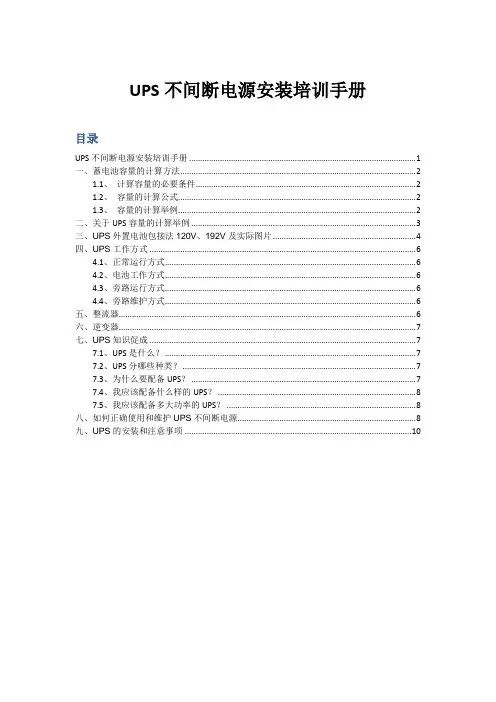
UPS不间断电源安装培训手册目录UPS不间断电源安装培训手册 (1)一、蓄电池容量的计算方法 (2)1.1、计算容量的必要条件 (2)1.2、容量的计算公式 (2)1.3、容量的计算举例 (2)二、关于UPS容量的计算举例 (3)三、UPS外置电池包接法120V、192V及实际图片 (4)四、UPS工作方式 (6)4.1、正常运行方式 (6)4.2、电池工作方式 (6)4.3、旁路运行方式 (6)4.4、旁路维护方式 (6)五、整流器 (6)六、逆变器 (7)七、UPS知识促成 (7)7.1、UPS是什么? (7)7.2、UPS分哪些种类? (7)7.3、为什么要配备UPS? (7)7.4、我应该配备什么样的UPS? (8)7.5、我应该配备多大功率的UPS? (8)八、如何正确使用和维护UPS不间断电源 (8)九、UPS的安装和注意事项 (10)一、蓄电池容量的计算方法蓄电池的容量必须是以所定的电压、所定的时间可向负载提供的容量。
以下就容量计算方法进行说明:1.1、计算容量的必要条件A、放电电流有必要明确放电过程中负载电流的增减变化和其随时间变化情况。
B、放电时间可预期的负载的最大时间。
C、最低蓄电池温度预先推定蓄电池放置场所的温度条件,决定蓄电池温度最低值。
一般设置在室内时为50C,设置在特别寒冷地区室内时为-50C。
用空调保证室内温度时按实际温度作为最低温度。
D、允许的最低电压单格允许的最低电压(V/单格)=(负载所允许的最低电压+导线的电压损失)/串联格数1.2、容量的计算公式C= 1*[K1I1+K2(I2-I1)、、、、、、、KN(IN-IN-1)]/LC:250C的额定放电率换算容量(AH)、、、、、、UXL电池是10HR 容量。
L:对因维护系数、使用年数、使用条件的变化而引起的容量变化而使用的修正值。
一般L值采用0.8。
K:由放电时间T、电池的最低使用温度、允许的最低电压而决定的容量换算时间。
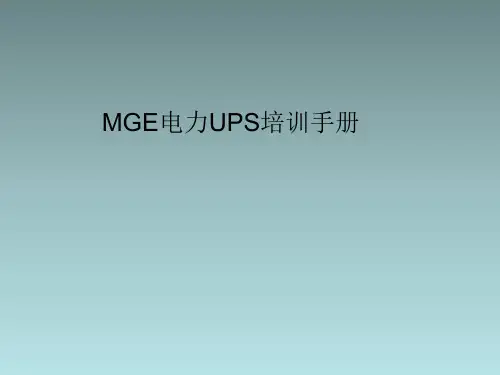
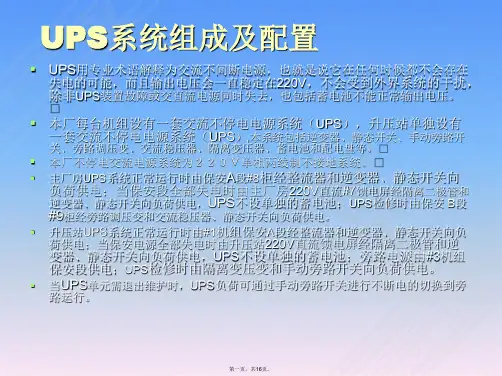

InventorySafety and General InformationInspect the package contents upon receipt. Notify the carrier and dealer if there is any damage.SAVE THESE INSTRUCTIONS - This manual contains important instructions that should be followed during installation and maintenance of the UPS and batteries. Failure to follow these instructions can result in equipment damage.UPS• This unit is designed for low power devices less than 50 Watts. When the UPS is on battery,the unit will shut down automatically to protect itself once the load on the UPS is greater than 50Watts.• This UPS is intended for indoor use only.• Do not operate this UPS in direct sunlight, in contact with fluids, or where there is excessivedust or humidity.• Be sure the air vents on the UPS are not blocked. Allow adequate space for properventilation.• The battery typically lasts for three to five years. Environmental factors impact battery life.Elevated ambient temperatures, poor quality AC power, and frequent short duration discharges will shorten battery life.• Connect the UPS power cable directly to a wall outlet.Mobile Power Pack (battery)• Do not short circuit this device. To avoid short circuit, keep the device away from any metalobjects (e.g., hair clips and keys).• It is normal that the battery will feel warm during heavy use.• Use this device as instructed to avoid electric shock; do not disassemble.• This unit is not user repairable; contact APC for tech support related issues.• Do not heat this device or throw it into a fire.• Do not drop or place the unit under a heavy object.• Keep this device away from high temperature, wet, or dusty environments.• During normal usage keep the device out in the open to allow excess heat to dissipate.• Charge M12USWH for 2.5 hours before initial use.• Keep the USB output port and micro-USB input port clean and free of obstruction.Getting StartedConnect the BatteryRemove all plastic films. With the USB ports positioned at the bottom, insert the mobile battery pack into the main unit.When the battery is inserted one LED will illuminate moving from the bottom to the top to confirm that the battery has been inserted properly.Using the UPSPress the POWER button located in frontof the UPS. The POWER button LED will illuminate and a single short beep will be audible to indicate that the UPS is turning on.The UPS provides surge protection and battery backup to low power equipment like modems, gateways, routers, cordless phone base units and V oIP base units.Note that high power devices like PCs or monitors may overload the UPS during a blackout. It is recommended that only low power devices be connected.Rotating OutletsBoth outlets can be rotated 90° and 45° to minimize adapter plug interference.USB charging portsThe three USB ports provide a total of 4.4A of DC power, and willprovide power even when the unit is on battery.Fast charging is available at the 2.4A USB port. This port integrates SmartCharging technology to maximize output according to the smartphone or tablet detected.Surge Only ModeThe battery can be removed and the UPS will continue to provide surge protection for the connected AC devices. When the battery is removed the POWER button LED will illuminate amber. In this mode the USB port will continue to provide charging power for smartphones and other USB devices.Mobile Power PackWhen removed from the UPS the battery can be used as a mobile power pack to charge devices in a mobile environment.To turn on the battery press the POWER button on the battery. The LEDs will illuminate to show battery capacity. After 20 seconds the unit will enter a power saving mode if it is not charging a device or being charged. If the unit is charging a device or being charged, after 20 seconds the LEDs will dim down to 10% brightness. Pressing the POWER button at any time will cause the LEDs to illuminate at 100% brightness for 20 seconds.Battery Charge and Capacity Information• Charge battery in the UPS for 2.5 hours prior to initial use. The battery will charge whetherthe UPS is on or off as long as there is AC power to the UPS.• Do not expect full battery runtime capability during the initial charge period.• To charge the battery using the micro-USB input, connect the battery to any USB chargingport. When separate from the UPS, battery charging is slower. When charging the battery using the USB port on a PC, the LEDs will flash more slowly to indicate slower rate of charge.• UPS runtime information is available on the APC Web site, .Mobile Power Pack Status IndicatorsUPS Status IndicatorsWall Mount Installation•Vertical installation, use 4 screws 15/16” (100 mm) in diame-ter. (Screws are not provided.)•Install the stabilizer feet using the 4 slots at the ends of each row of ventilation holes as seen in the figure below.•Orient the UPS to the desired location. Mount screws directly into stabi-lizer feet starting with the bottom pair.Capacity indicator LEDs UPS connector Mobile power pack (battery)Mobile Power Pack POWER buttonRotating outletsPower cordUSB cable Stabilizer feet (4 pcs)User Manual from the UPS and the battery.Plug the power cord into the back of the unit.Install the stabilizer feet using the 4 slots at the ends of each row of ventila-tion holesEventPOWER Button LED Audible Indicator On On Battery The LED flashes green.Not applicable Surge Only ModeThe LED illuminates amber.Not applicableLow Battery alarmThe UPS is supplying battery power and the battery is near a total discharge state.The LED illuminates green and flashes rapidly.The UPS emits 2 short beeps every 30 seconds.Replace BatteryThe battery is worn or needs to be replaced.The LED illuminates red only.None Overload ShutdownWhile on battery power an overloadcondition has occurred in one or more of the battery backup outlets while the UPS is operating on battery power.None Constant toneUSB Detected FaultAn error has occurred in the USB charger on the UPS.The LED alternatelyilluminates green / amber.None© 2015 APC by Schneider Electric. APC, the APC logo, and Back-UPS are owned by Schneider Electric Industries S.A.S., or their affiliated companies. All other trademarks are property of their respective owners.EN 990-966901/2015Voltage Sensitivity Adjustment (optional) The UPS detects and reacts to line voltage distortions by transferring to battery backup power to protect connected equipment. In situations where either the UPS or the connected equipment is too sensitive for the input voltage level it is necessary to adjust the transfer voltage.1.Connect the UPS to a wall outlet but make sure it is off.2.Press and hold the POWER button. After 10 seconds the POWER button LED will illuminatealternately green-red to indicate that the UPS is in Program mode.3.After releasing the POWER button the POWER button LED will illuminate either green,amber, or red to indicate the current sensitivity level. Press the POWER button to changesensitivity. Refer to the table below for an explanation of the sensitivity setting and transfervoltage sensitivity level that corresponds to each LED color.4.To exit Program mode wait five seconds and all LED indicators will extinguish. Programmode is no longer active.Mute Low Battery AlarmFollow the instructions below to adjust the audio setting of the UPS to enable or disable low battery alarm. To change the setting make sure the UPS is on.Make sure the unit is on. Press and hold the POWER button. Releasing the POWER button after hearing the 3rd short beep will toggle the low battery alarm mute function. The UPS will emit a short double beep to confirm that the low battery alarm has been disabled. If the UPS emits a 1- second beep it indicates that the low battery alarm is audible.Note: The default setting of the low battery alarm is audible.UPS SpecificationsMobile Power Pack (battery) SpecificationsReplace BatteryDeliver the used battery to a recycling facility.Replace the used battery with an APC by Schneider Electric approved battery.Replacement batteries can be ordered through the APC by Schneider Electric Website, . Battery replacement part for UPS BGE50ML is M12USWH. WarrantySchneider Electric IT (SEIT) warrants its products to be free from defects in materials andworkmanship for a period of three (3) years from the date of purchase. SE IT obligation under this warranty is limited to repairing or replacing, at its sole discretion, any such defective products. This warranty does not apply to battery wear from use, equipment that has been damaged by accident, negligence or misapplication or has been altered or modified in any way. SEIT standard procedure is to replace the original unit with a factory reconditioned unit. Customers who must have the original unit back due to the assignment of asset tags and set depreciation schedules must declare such a need at first contact with an SEIT Technical Support representative. SEIT will ship the replacement unit once the defective unit has been received by the repair department, or cross ship upon the receipt of a valid credit card number. The customer pays for shipping the unit to SEIT.SEIT pays ground freight transportation costs to ship the replacement unit to the customer. For full warranty information refer to .TroubleshootingServiceIf the unit requires service, do not return it to the dealer. Follow these steps:1.Review the Troubleshooting section of the manual to eliminate common problems.2.If the problem persists, contact Schneider Electric IT (SEIT) Customer Support through theAPC by Schneider Electric Web site, .a.Note the model number and serial number and the date of purchase.b.Call SEIT Customer Support and a technician will attempt to solve the problem over thephone. If this is not possible, the technician will issue a Returned Material AuthorizationNumber (RMA#).c.If the unit is under warranty, the repairs are free.d.Service procedures and returns may vary internationally. Refer to the APC by SchneiderElectric Web site for country specific instructions.3.Pack the unit in the original packaging whenever possible to avoid damage in transit. Neveruse foam beads for packaging. Damage sustained in transit is not covered under warranty.4.Always DISCONNECT THE UPS BATTERIES before shipping. The United StatesDepartment of Transportation (DOT), and the International Air Transport Association(IATA) regulations require that UPS batteries be disconnected before shipping. Theinternal batteries may remain in the UPS.5.Write the RMA# provided by Customer Support on the outside of the package.6.Return the unit by insured, pre-paid carrier to the address provided by Customer Support APC by Schneider Electric IT Customer Support WorldwideFor country specific customer support, go to the APC by Schneider Electric Web site,.EMC ComplianceThis device complies with part 15 of the FCC rules. Operation is subject to the following two conditions: (1) This device may not cause harmful interference, and (2) This device must accept any interference received, including interference that may cause undesired operation.This UPS is certified to comply with California Battery Charger System regulations. Formore information go to/site/recycle/index.cfm/energy-efficiency/cec-battery-charger/LED Flashes SensitivitySettingInput Voltage Range(AC Operation)Recommended UseGreen LOW88 Vac to 142 Vac Use this setting with equipment that is less sensitive to fluctuations in voltage or waveform distortions.Red MEDIUM92 Vac to 139 Vac Factory default setting. Use this setting undernormal conditions.Amber HIGH96 Vac to 136 Vac Use this setting when connected equipment issensitive to voltage and waveform fluctuations.AC Input V oltage120 Vac NominalFrequency50/60 Hz + 3Hz auto-sensingBrownout Transfer92 Vac TypicalOver-voltage Transfer139 Vac TypicalProtection Resettable circuit breakerSurge Protection Computer gradeAC Output UPS Capacity 84 V A, 50 WTotal Amperage (AC outlets)0.7 AV oltage - On Battery115 Vac ± 8%Frequency - On Battery50/60 Hz + 1Transfer Time 6 ms Typical, 10 ms maximumUSB Output Output Current 1.0AOutput V oltage5VCharger Compatibility USB Battery Charging Specification 1.2Physical Net Weight 1.7 lb (0.8 kg)DimensionsLength x Width x Height 7.7 in x 7.0 in x 2.1 in (19.6 cm x 17.8 cm x 5.4 cm)Operating Temperature32º F to 104º F (0º C to 40º C) Storage Temperature5º F to 113º F (–15º C to 45º C) Operating Relative Humidity0 to 95% non-condensing humidity Operating Elevation0 to 10,000 ft (0 to 3000 m)Cord Lengths Power Cord59.0 in (150.0 cm) USB Cord11.0 in (27.9 cm)Type Lithium-ion batteryCapacity11400mAhRating41.2 WhInput current (Maximum)micro-USB: 2.1ARated input voltage5V dcOutput current USB1: 2.4A, USB2: 1.0AOutput voltage5VCapacity indicator light 5 level LEDsCapacity indicator brightness levels50% in the UPS. As mobile power pack 100% afterpressing the POWER button. 10% after 20 secondswhen charging a device or being charged. Charging time 2.5 hours (UPS), 8 hours (micro-USB) Dimensions (L x W x H) 5.1 x 2.9 x 0.9 in (13.0 x 7.4 x 2.2 cm)Weight0.6 lb (267g)Operating temperature32°F- 104°F (0°C- 40°C)Smart Charging (2.4A port only)Maximum output depends on the client device.Problem and Possible Cause SolutionThe UPS will not turn onThe UPS has not been turned on.Press the POWER button.The UPS is not connected to AC power,there is no AC power available at the walloutlet, or the AC power is experiencing abrownout or over voltage condition.Make sure the battery has been inserted into the UPSwhen attempting to turn on the UPS without AC power.In the event that the UPS receives no AC power and thebattery is connected, a cold-start can be initiated. Pressand hold the POWER button until the UPS emits twobeeps.The UPS is on, the POWER button illuminated redThe battery is worn or needs repair..Contact Schneider Electric IT (SEIT) Technical Supportfor more in depth troubleshooting..Connected equipment loses powerA UPS overload condition has occurred.Remove all nonessential equipment connected to theoutlets. Reconnect equipment to the UPS, one device at atime.The battery is completely discharged.Connect the UPS to AC power to allow the battery torecharge.The UPS may require service.Contact Schneider Electric IT (SEIT) Technical Supportfor more in depth troubleshooting.The UPS has an inadequate battery runtimeThe battery is not fully charged.The battery is near the end of useful lifeand should be replaced.Leave the UPS connected to AC power for 2.5 hourswhile the battery charges to full capacity.As a battery ages, the runtime capability decreases.Contact APC by Schneider Electric at the Web site, to order replacement batteries.USB charging is slowCharging a device using the UPS's USBcharger is slower than the device's originalUSB chargerThe amount of power a device draws depends on itscompatibility with the USB Battery ChargingSpecification 1.2. Compatible devices can draw morepower than devices that are less compatible. For devicesthat can charge using input greater than 1A make sure thatthe device is connected to the 2.4A USB charging port. USB charging stops and the POWER button LED alternately illuminates green / amberThe USB port on the UPS is overloaded orhas encountered an error.Disconnect device from the USB port on the UPS. USBcharging will resume when the LED turns green. ContactSEIT Technical Support if the LED continues to alternategreen / amber.USB charging stops and the battery pack capacity indicators LEDs all flash simultaneously One or two USB ports on the mobile powerpack is overloaded or has encountered anerror.Disconnect device(s) from the USB port(s) on the mobilepower pack. When the mobile power pack is not pairedwith the UPS the power pack will enter safe mode if theUSB error has not been resolved within 30 seconds. Battery charging is slowThe charging time of battery variesdepending on the charging connection.Charge the battery inside the UPS for best results. Usingthe micro-USB port to charge the battery will requiremore time. The speed is also dependent on the type ofUSB charger. Some USB chargers support 1A and othersup to 2.4A. More powerful chargers will reduce the timerequired. USB ports on a PC can also charge the batterybut older PCs only support 500mA which will result ineven more time to charge.。
Powsys UPS 注意事项一、UPS开机步骤1闭合旁路柜的市电输入开关,把开关打到稳压位置。
2依次闭合ST/SW(旁路)开关,CHARGER(整流主输入)开关,UPS开始系统自检,大约1分钟,面板显示UPS OFF,面板上CHARGER和BYPASS灯亮。
3闭合BATTERY电池开关。
4按面板上的ON/OFF按钮一次,UPS开始起机,等待大约1分钟,面板显示UPS OK,面板上INVERTER ,INV及SYNC灯亮,机器内部没有任何报警,则说明UPS已启动完毕。
5闭合OUTPUT(输出)开关,UPS输出到馈线柜。
6闭合馈线柜上的对应开关。
7依次按照功率从大到小启动负载。
二、UPS关机步骤1依次关断负载.2依次关断馈线柜上的开关。
3按面板上的ON/OFF按钮两次,,关闭逆变,UPS无输出电压。
4依次关断UPS主机上的OUTPUT,BATTERY,ST/SW,CHARGER开关,关断UPS主机。
5把旁路柜上的开关由稳压打到停止,关闭旁路柜上的开关,关闭旁路输出。
三、UPS 正常状态转维护旁路操作步骤1 保证UPS在正常运行状态,SYNC、INV和BYPASS灯必须亮。
按UPS面板的B/P/INV按钮两次,把UPS转到旁路状态,面板BYPASS,B/P灯必须亮。
2 闭合MAIN(维护旁路)开关,把UPS转到市电直接供电状态。
3 关断OUTPUT(输出)开关。
3 按面板的ON/OFF按钮两次,关闭UPS逆变,面板INVERTER灯灭。
4 依次关断BATTERY(电池开关),ST/SW(旁路开关),CHARGER(整流器主电源开关)四、UPS由维护状态转换到正常状态1 依次闭合ST/SW(旁路)开关,CHARGER(整流主输入)开关,UPS开始自检,等待约1 分钟,面板显示UPS OFF,面板上CHARGER和BYPASS 灯亮。
2 闭合BATTERY(电池)开关,按面板的ON/OFF按钮,等待1分钟左右自检,启动逆变器,面板INVERTER,INV,SYNC灯亮。
地铁用信号电源设备理论培训手册佛山市南海区创电电源有限公司二○○七年四月目录第一部分基本知识1.UPS的基本知识----------------------------------------------------------------------------------------------41.1 UPS电源是什么电源----------------------------------------------------------------------------------41.2 UPS分类----------------------------------------------------------------------------------------------4-51.3 信息技术设备为什么要用UPS电源---------------------------------------------------------------51.4 当前UPS电源设备发展状况-------------------------------------------------------------------------51.5 目前市场上销售量最大的三种类型UPS介绍-------------------------------------------------5-91.6 有关UPS电源的术语----------------------------------------------------------------------------10-1 22.几种常用电器元件的基本知识--------------------------------------------------------------------------122.1 继电器--------------------------------------------------------------12-142.3 空气断路器在电气电路保护设计中的重要性------------------------------15-19 2.4 C级防雷系统------------------------------------------------------------19 2.5 数字电流、电压表--------------------------------------------------------202.7 分流器、电流互感器---------------------------------------------------20-212.8 变压器、电抗器------------------------------------------------------21-222.9 电源滤波器(EMI)-------------------------------------------------------222.10 静态开关---------------------------------------------------------------232.11 绝缘栅双极晶体管(IGBT)--------------------------------------------23-26 2.12 霍尔电压电流传感器--------------------------------------------------26-27第二部分信号电源系统设备知识1.北京地铁2号线信号系统设备简介------------------------------------------------------------------281.1 概述-----------------------------------------------------------------------------------------------------281.2 整机外形图----------------------------------------------------------------------------------------28-342.CDT5(含10-30)K-HW UPS电源柜----------------------------------------------------------------352.1 前言-----------------------------------------------------------------------------------------------------352.2 UPS电源柜工作原理----------------------------------------------------------------------------36-42.3 双路输入切换单元控制原理-----------------------------------------------------------------------402.4全自动交流稳压器单元工作原理-----------------------------------------------------------------413.U P S电源电气原理图-------------------------------------------------------------------------------------42 3.1C D T5-H W U P S电源柜电气原理图---------------------------------------------------------------42 3.2C D T10K-H W U P S电源柜电气原理框图--------------------------------------------------------43 3.3C D T20/25/30K-H W U P S电源柜电气原理框图------------------------------------------------44 4.电源柜电气连线图-------------------------------------------------------------------------------------45-49 5.U P S电源柜电气性能表-------------------------------------------------------------------------------5 0-51 6.U P S电源柜外形结构图-------------------------------------------------------------------------------5 2-56 7.接线排接线图--------------------------------------------------------------------------------------------57-61 8.U P S电源柜安装、调试规范要求-----------------------------------------------------------------------62 8.1U P S安装原理-----------------------------------------------------------------------------------------62 8.2安装前准备检查工作--------------------------------------------------------------------------------628.3 安装步骤---------------------------------------------------------------62 8.4 调度步骤---------------------------------------------------------------63 9.操作使用方法-----------------------------------------------------------------------------------------------64 9.1双路输入单元的操作--------------------------------------------------------------------------------64 9.2 UPS单元的操作----------------------------------------------------------64 9.3 旁路稳压器单元的操作---------------------------------------------------65 9.4 在维修旁路的使用-------------------------------------------------------65 9.5 液晶显示面板操作规程------------------------------------------------66-84 10.输出负载能力----------------------------------------------------------------------------------------------84 11.保养维护及储存-------------------------------------------------------------------------------------------85 11.1U P S日常保养------------------------------------------------------------------------------------------85 11.2U P S储存------------------------------------------------------------------------------------------------85 12.U P S电源柜故障排除指南---------------------------------------------------------------------------86-89 13.U P S主要配件清单---------------------------------------------------------------------------------------91 14.附录---------------------------------------------------------------------------------------------------------95附录1、U P S电源容量配置的计算方法-----------------------------------------------------------95-96附录2、汤江牌蓄电池特点及使用注意事项----------------------------------------------------------97附录3、蓄电池组在线监测终端按键操作要点-------------------------------------------------------99附录4、U P S电源柜检修程序及技术标准------------------------------------------------------102-105第一部分基本知识1. UPS的基本知识1.1 UPS电源是什么电源。
一.硬件部分1.APC UPS 的分类Back-UPSBack-UPS Pro(含P&P)Smart-UPS系列Matrix-UPS系列Symmetra电源阵列2.安装环境(1)环境温度:0~+45度(2)相对湿度:0~95%(3)海拨:3000米以下。
(4)主机离开墙壁至少10公分以上。
(5)保持主机、电池通风良好。
3.电源需求220VAC,50Hz,单相交流电,带保护地线。
对于不同的UPS主机,需要用户提供相应容量的电力保障。
电源输入线需要由用户自己提供。
请注意:UPS不要与空调等感性负载共用一路电源。
4.主机安装(1)选择主机的安装位置。
(2)连接电池:如果使用的是组装电池,对于外接电池电压为24V的主机,每组电池采用2节12V电池串联;对于外接电池电压为48V的UPS,每组电池采用4节12V电池串联。
根据主机容量及满载延时间的长短采用多组电池组并联。
组装电池的连接方法见图一、图二。
如果使用的是APC的原装电池箱,其连接方法见图三。
电池间连线的选择:请务必使用合理的线径,以确保安全。
(3)连接UPS输入、输出电源:确认主机的电源开关处于断开位置,然后将电池接到主机上,将主机接入市电,如图四所示。
APC UPS的电源输出线只有四根,且每根长度仅为1.8米,如果用户的用电设备距离UPS主机较远,请用接线板接续,或将接线板的电源线直接接到UPS后面板的输出接线端子上。
二.软件部分APC 的UPS监控软件PowerChute Plus 支持下述软件平台:Windows3.x Windows95 WindowsNTNetWare Apple OS/2LAN MAN LAN Server SINIXSCO Unix NCR Unix Solaris SparcSolaris Intel AIX PS/2 AIX RS/6000UnixWare HP-UX DEC VAX/VMSSGI Irix DEC OSF/1 Solaris JLEOpen VMS Olivetti UNIX1.软件安装参见《PowerChute Plus User's Guide》。
UPS系统培训资料一、UPS 系统概述UPS,即不间断电源(Uninterruptible Power Supply),是一种能够提供持续、稳定、纯净电力供应的设备。
在现代社会中,无论是企业的数据中心、医疗设备、通信基站,还是家庭中的重要电器设备,都离不开 UPS 的保障。
UPS 系统的主要作用是在市电出现异常(如停电、电压波动、频率异常等)时,能够迅速切换到电池供电模式,确保所连接的设备能够不受影响地继续正常运行。
这样可以有效地避免因电力问题导致的数据丢失、设备损坏、业务中断等严重后果。
二、UPS 系统的分类1、按工作原理分类(1)在线式 UPS在线式 UPS 始终让市电先经过逆变器转换后再供给负载。
在市电正常时,UPS 对市电进行滤波、稳压和调整后输出;市电异常时,电池通过逆变器向负载供电。
这种类型的UPS 输出电压稳定,电能质量高,能够为负载提供最佳的保护,但成本相对较高。
(2)离线式 UPS离线式 UPS 在市电正常时,市电直接供给负载,同时对电池充电;市电异常时,迅速切换到电池逆变供电。
其特点是结构简单、成本低,但电能质量相对较差,切换时间较长。
(3)在线互动式 UPS在线互动式 UPS 结合了在线式和离线式的特点。
市电正常时,通过调整变压器来补偿市电的电压波动;市电异常时,切换到电池逆变供电。
它的性能和成本介于在线式和离线式之间。
2、按供电方式分类(1)单相 UPS适用于小型设备和家庭用户,一般供电功率较小。
(2)三相 UPS主要用于大型企业和数据中心等场所,供电功率较大。
3、按电池类型分类(1)铅酸蓄电池 UPS铅酸蓄电池是目前应用最广泛的 UPS 电池类型,成本较低,但寿命相对较短,维护要求较高。
(2)锂离子电池 UPS锂离子电池具有更高的能量密度、更长的寿命和更轻的重量,但成本较高。
三、UPS 系统的组成部分1、整流器将市电交流电转换为直流电,为电池充电并提供给逆变器。
2、逆变器将直流电转换为交流电,为负载提供稳定的电力输出。
UPS不间断电源安装培训手册目录UPS不间断电源安装培训手册 (1)一、蓄电池容量的计算方法 (2)1.1、计算容量的必要条件 (2)1.2、容量的计算公式 (2)1.3、容量的计算举例 (2)二、关于UPS容量的计算举例 (3)三、UPS外置电池包接法120V、192V及实际图片 (4)四、UPS工作方式 (6)4.1、正常运行方式 (6)4.2、电池工作方式 (6)4.3、旁路运行方式 (6)4.4、旁路维护方式 (6)五、整流器 (6)六、逆变器 (7)七、UPS知识促成 (7)7.1、UPS是什么? (7)7.2、UPS分哪些种类? (7)7.3、为什么要配备UPS? (7)7.4、我应该配备什么样的UPS? (8)7.5、我应该配备多大功率的UPS? (8)八、如何正确使用和维护UPS不间断电源 (8)九、UPS的安装和注意事项 (10)一、蓄电池容量的计算方法蓄电池的容量必须是以所定的电压、所定的时间可向负载提供的容量。
以下就容量计算方法进行说明:1.1、计算容量的必要条件A、放电电流有必要明确放电过程中负载电流的增减变化和其随时间变化情况。
B、放电时间可预期的负载的最大时间。
C、最低蓄电池温度预先推定蓄电池放置场所的温度条件,决定蓄电池温度最低值。
一般设置在室内时为50C,设置在特别寒冷地区室内时为-50C。
用空调保证室内温度时按实际温度作为最低温度。
D、允许的最低电压单格允许的最低电压(V/单格)=(负载所允许的最低电压+导线的电压损失)/串联格数1.2、容量的计算公式C= 1*[K1I1+K2(I2-I1)、、、、、、、KN(IN-IN-1)]/LC:250C的额定放电率换算容量(AH)、、、、、、UXL 电池是10HR容量。
L:对因维护系数、使用年数、使用条件的变化而引起的容量变化而使用的修正值。
一般L值采用0.8。
K:由放电时间T、电池的最低使用温度、允许的最低电压而决定的容量换算时间。
I:放电电流下标1、2、、、、N:按放电电流变化顺序依次加给T、K、I1.3、容量的计算举例A、放电电流 140A(一定)B、放电时间 30分C、最低蓄电池温度 -550CD、允许的最低电压 1.6V/单格按上述条件,得出K=1.1C= 1 X1.1X140=192(AH/10HR)/0.8所以,可使用UXL220-2。
注:上述例子是针对放电电流一定的简单的负载类型电池容量的计算。
其他负载类型的计算请参考日本蓄电池工业标准[SBA6001]。
二、关于UPS容量的计算举例计算机设备应该加装不间断电源保护,其有两个主要作用:一是在市电中断时重要用电设备有干净纯洁的电源使用;二是在市电没有中断时,但是电源有杂波干扰,电压忽高忽低,频率变化频繁而影响计算机正常运行,如果经过UPS,其有稳压稳频的作用,电源干净可靠。
UPS的配置先要考虑哪些重要用电设备要做电源保护,从而计算出其负载;如PC机一般其容量为250W,计算机常用的服务器为700W,如果以PC机作为服务器一般以300W计算,HUB交换机为100W,(注意:计算容量时只能以最大负荷计算)例如:一个计算机机房有4台PC机,一台服务器,一个网络交换机需要进行2小时电源保护,计算如下:1)总负载计算4台PC机250W X 4 = 1000W1台服务器700W X 1 = 700W1台网络交换机100W X 1 =100W以上合计:1800W2)UPS容量计算在线式UPS一般功率因数为0.8,1800W÷0.8=2250VA,考虑UPS 容量的冗余,一般以20%到30%(因为UPS的最佳工作状态就是负载70%到80%);所以设计推荐UPS容量应该为2250VA X 1.3 = 2925VA,从而可以得出选用3000VA的UPS3)品牌的选择在线式UPS当今市场上比较常用的知名品牌有美国山特,因为APC 不是纯在线式UPS,所以我们推荐使用美国山特3000VA的UPS,型号为STK C3KS4)电池容量的计算美国山特3000VA型号为STK C3KS的UPS的功率因数为0.8(查资料可以得出),所以3000VA实际功率为3000VA X 0.8 = 2400W;美国山特3000VA型号为STK C3KS的UPS的电池直流电压为96V(查资料可以得出),根据W = U X I,所以I = W ÷ U =2400 ÷ 96 = 25A,计算得出电流为25A,延时1小时得用25AH的电池,现在需要延时2小时,即需要50AH的电池。
现在市场上常用的知名电池有沈阳松下,其常用的容量有24AH-12V;38AH-12V;65AH-12V;100AH-12V;根据以上计算可以选用65AH-12V的沈阳松下蓄电池一组就可以延时2小时。
因为UPS常用电池电压为12V,而C3KS UPS的电池电压为96V,所以应该需要8节(96V ÷ 12V =8)。
从而可以计算得出选用美国山特3000VA的UPS,配置8节65AH-12V 的沈阳松下蓄电池,加一个电池柜,可以让受保护的设备延时2小时电源保护。
三、UPS外置电池包接法120V、192V及实际图片四、UPS工作方式4.1、正常运行方式不断电系统的供电原理是当市电正常时,机器会将市电的交流电转换为直流电,而后对电池充电,以备电力中断时使用;这里跟各位强调的是不断电系统并不是停电时才会动作,像是遇到电压过低或过高、瞬间突波等,足以影响设备正常运转的电力品质时,不断电系统均会动作,提供设备稳定且干净的电力。
当市电正常供电时,市电经滤波回路后,分为两个回路同时动作,其一是经由充电回路对电池组充电,另一个则是经整流回路,作为逆变器的输入,再经过逆变器的转换提供电力给负载使用;由此可知,在线式不断电系统的输出完全由逆变器来供应,因此不论市电电力品质如何,其输出均是稳定而不受任何影响。
4.2、电池工作方式一旦市电发生异常时,将储存于电池中的直流电转换为交流电,此时逆变器的输入改由电池组来供应,逆变器持续提供电力,供给负载继续使用,达到不断电的功能。
不断电系统的电力来源是电池,而电池的容量是有限的,因此不断电系统不会像市电一般无限制的供应,所以不论多大容量的不断电系统,在其满载的的状态下,其所供电的时间必定有限,若要延长放电时间,须购买长时间型不断电系统。
4.3、旁路运行方式当在线式UPS超载、旁路命令(手动或自动)、逆变器过热或机器故障,UPS 一般将逆变输出转为旁路输出,即由市电直接供电。
由于旁路时,UPS输出频率相位需与市电频率相位相同,因而采用锁相同步技术确保UPS输出与市电同步。
旁路开关双向可控硅并联工作方式,解决了旁路切换时间问题,真正做到了不间断切换,控制电路复杂,一般应用在中大功率UPS上。
如果在过载时,必须人为减少负载,否则旁路短路器会自动切断输出。
4.4、旁路维护方式当UPS进行检修时,通过手动旁路保证负载设备的正常供电,当维修操作完成后,重新启动UPS, UPS 转为正常运行。
极低的维护率,MTTR为15分钟,极大地提高UPS可用性五、整流器整流器是一个整流装置,简单的说就是将交流(AC)转化为直流(DC)的装置。
它有两个主要功能:第一,将交流电(AC)变成直流电(DC),经滤波后供给负载,或者供给逆变器;第二,给蓄电池提供充电电压。
因此,它同时又起到一个充电器的作用;六、逆变器通俗的讲,逆变器是一种将直流电(DC)转化为交流电(AC)的装置。
它由逆变桥、控制逻辑和滤波电路组成;七、UPS知识促成7.1、UPS是什么?UPS是不间断电源(Uninterruptible Power Supply)的英文简称,是能够提供持续、稳定、不间断的电源供应的重要外部设备。
从原理上来说,UPS是一种集数字和模拟电路,自动控制逆变器与免维护贮能装置于一体的电力电子设备;从功能上来说,UPS可以在市电出现异常时,有效地净化市电;还可以在市电突然中断时持续一定时间给电脑等设备供电,使你能有充裕的时间应付;从用途上来说,随着信息化社会的来临,UPS广泛地应用于从信息采集、传送、处理、储存到应用的各个环节,其重要性是随着信息应用重要性的日益提高而增加的。
7.2、UPS分哪些种类?UPS按工作原理分成后备式、在线式与在线互动式三大类:2.1、后备式UPS是我们最常用的,它具备了自动稳压、断电保护等UPS最基础也最重要的功能,虽然一般有10ms左右的转换时间,逆变输出的交流电是方波而非正弦波,但由于结构简单而具有价格便宜,可靠性高等优点,因此广泛应用于微机、外设、POS 机等领域;2.2、在线式UPS结构较复杂,但性能完善,能解决所有电源问题,其显著特点是能够持续零中断地输出纯净正弦波交流电,能够解决尖峰、浪涌、频率漂移等全部的电源问题;由于需要较大的投资,通常应用在关键设备与网络中心等对电力要求苛刻的环境中;2.3、模块化UPS与传统UPS相比有诸多优点,代表UPS的发展方向之一,但目前还存在成本高,部分产品实际的可靠性并不如理论计算值高,但安全系数已经远远超过传统UPS;对模块化UPS的研究将有利于促进模块化的可靠性提高,从而提高模块化UPS在客户中的认可度,加快模块化UPS的发展。
EAST(易事特)模块化UPS每个模块就是一台独立工作的UPS,功率段齐全可选,高效率低干扰,环保节能,安全系数高。
7.3、为什么要配备UPS?据IDC统计,全部电脑故障的45%是由电源问题引起的;在中国,大城市停电的次数平均为0.5次/月,中等城市为2次/月,小城市或村镇为4次/月,电网存在至少九种问题:断电、雷击尖峰、浪涌、频率震荡、电压突变、电压波动、频率漂移、电压跌落、脉冲干扰;因此从改善电源质量的角度来说给电脑配备一台UPS是十分必要的。
另外,精密的网络设备和通信设备是不允许电力有间断的,以服务器为核心的网络中心要配备UPS是不言而喻的,即使是一台普通电脑,其使用三个月以后的数据文件等软件价值就已经超过了硬件价值,因此为防止数据丢失而配备UPS也是十分必须的。
7.4、我应该配备什么样的UPS?根据设备的情况、用电环境以及想达到的电源保护目的,可以选择适合的UPS;例如对内置开关电源的小功率设备一般可选用后备式UPS,在用电环境较恶劣的地方应选用在线互动式或在线式UPS,而对不允许有间断时间或时刻要求正弦波交流电的设备,就只能选用在线式UPS。
7.5、我应该配备多大功率的UPS?首先要确定您的设备是多大功率的,一般来讲普通PC机或工控机的功率在200W左右,苹果机在300W左右,服务器在300W与600W之间,其他设备的功率数值可以参考该设备的说明书。
其次应了解UPS的额定功率有两种表示方法:视在功率(单位VA)与实际输出功率(单位W),由于无功功率的存在所以造成了这种差别,两者的换算关系为:视在功率*功率因数=实际输出功率后备式、在线互动式的功率因数在0.5与0.7之间,在线式的功率因数一般是0.8。